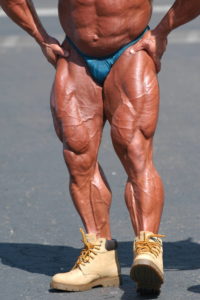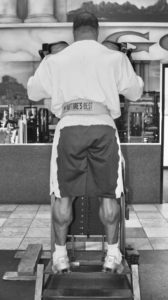The First Step in Calf Training

How to stretch your calves to help them grow
By Strength Sensei CP
Most often bodybuilders don’t ask me how to improve their calf development…until it’s too late. Seriously, for those who are not genetically gifted in the lower leg department and want symmetrically total leg development, calf training needs to take center stage in program design. To get you started, here is one tip I’d like to share with you to accelerate your calf development.
As with any muscle group, for maximum development, you need to work the muscles through a full range of motion. Compare the quadriceps development of powerlifters versus weightlifters. Because weightlifters work their legs through a full range of motion, they tend to have better overall development of the quads, especially in the muscles around the knee. Powerlifters, in contrast, tend to only have significant development on the upper portion of the quads as their competitive squat doesn’t require them to squat all the way down.
For this reason, one of the most valuable tips I have for those seeking to improve their calf development is to stretch the calves. But it’s not as simple as the popular runner’s stretch where you lean against a wall with one leg behind the other, holding for half a minute, and then repeating for the other leg.
First, consider that there are two calf muscles, the gastrocnemius (upper calf) and soleus (lower calf). Each needs to be stretched separately. However, I’ve found that traditional static stretches are often not enough.
To stretch the calves, you will need extra resistance. And the best way to stretch your calves you will need two machines, a standing calf machine and a seated calf machine.

The standing calf machine can be used to both strengthen and stretch the calf muscle. (photos by Miloš Šarčev)
Before every calf training session, perform the following workout.
Start with the standing calf machine to stretch the gastrocnemius. Position your shoulders under the pads of the machine, straighten your legs and lock your knees. Slowly lower your heels as low as possible; it’s important to keep your knees locked to stretch the gastrocnemius completely. Hold for 15 seconds, bend your knees, and release the resistance from the shoulder pads. Rest five seconds, then add a small amount of resistance. Repeat this sequence for another 3 to 5 reps.
Now move on to the seated calf machine to stretch the soleus. Position your upper thighs under the pads of the machine, then slowly lower your heels as low as possible. Repeat the sequence of the “stretch 15 seconds/rest 5 seconds/add weight” for a total of 5 to 7 reps as with the standing calf machine.
To test the effectiveness of this system. Before the stretching, perform a deep squat and note the position of your shins in relation to the floor. Stretch the muscles as described, then re-test. If you have tightness in your calves, you should see a dramatic change.
Caution: At first, you should not perform all the reps or use heavy resistance, especially if you do not perform calf work regularly. To avoid injury, at first use light weights and only perform 2 sets for each stretch, using minimal resistance. As you become accustomed to the stretches, gradually increase the number of reps for each exercise and the resistance. This may take several weeks. Also, women who wear high heels will have to approach this stretching method extremely conservatively, as the elevated heels of these shoes tend to create especially tight calves.
Calf training may not be the most enjoyable part of your workouts, but if you’re going to invest the time and energy into working them, try this approach to stretching them to help them grow! (SS)
